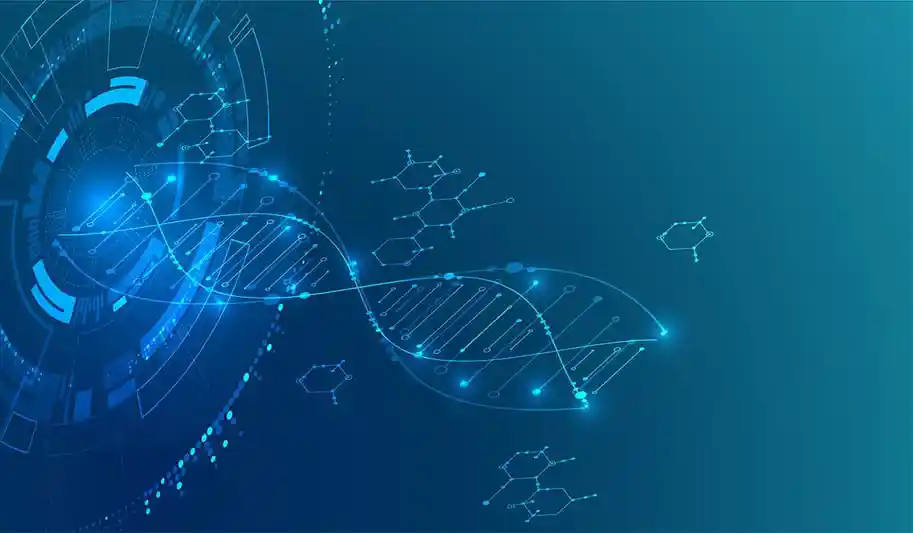
Feb 16, 2023
Blog Life Sciences DNA: Nature’s answer to the modern data problem
Data, data everywhere. In a world where almost everything is recorded digitally, we produce masses of the stuff. So much so, that 90% of digital data worldwide has been generated in the past two years alone. As technology becomes more complex, prompted by the growth in search engines, social media websites, smart cars, and the IoT, the amount of data we produce will snowball. This begs the question: how to store it all?
With the impending data flood in mind, current storage systems prove wildly insufficient. Magnetic tapes, hard drives, and optical discs are inching further toward their density limits. Plus, they can be damaged and have limited life spans: Magnetic tapes, used for most digital archives, have a maximum life span of fewer than thirty years.
There is a solution, though unconventional: DNA, nature’s answer to data storage.
In many ways, it makes sense: DNA houses the code that forms the instructions for life. It’s incredibly stable, with numerous examples of long-term stability. For example, the DNA of a 700,000-year-old horse, stored in permafrost, was successfully sequenced in 2013. The industry is still in its infancy, but technologies are rapidly progressing. In the technological age, it seems oddly befitting that scientists are looking to the original source for answers.
How DNA data storage works
While electronic data are stored in the binary digits 0 and 1, DNA uses the bases ACGT, standing for adenine, cytosine, guanine, and thymine. With their recognizable double-helix structure, the systems are compact, allowing for far more expansive data storage.
As measured in bits per unit volume, flash memory is capable of storing 1 bit of data in about 10 nanometers. DNA can store 2 bits in 0.34 nm. Put another way, one kilogram of DNA can store 2x1024 bits; the same amount requires greater than 109 kg of silicon for flash memory.
What’s the catch?
Currently, a central challenge in synthesis is producing longer strands of DNA. DNA strands that are longer than 200 nucleotides are difficult to obtain with high fidelity because of accumulated errors in synthesis.
It’s also been a historically expensive technology to develop. In 2001, sequencing of the first human genome was completed for $95,000,000 and took three years. Since then, next-generation sequencing technologies have rapidly progressed, making the process more affordable. In 2021, scientists sequenced an entire genome for under $500, and work is underway to lower the costs of
DNA data storage further.
But the question of ownership and privacy remains. Currently, large corporations like Microsoft and government bodies in collaboration with academic organizations are the main proprietors of DNA storage technologies. These bodies are involved in collecting, storing, and using the data, but naturally, concerns are arising regarding the use of personal data and privacy breaches.
More importantly, there are no current standardized regulations or guarantees regarding data security and the use of technology through third parties. While there are solutions, they’re imperfect. In the long term, organizations could design affordable, public-use systems that prioritize data management for archival and retrieval. In the short term, technology owners could promote better awareness and understanding of the process of DNA-based storage systems and associated customer rights.
Where is the DNA data storage market heading?
There are hurdles to overcome, but the technology will prove game-changing for academia, governments, the intelligence community, financial services, and healthcare. Industries with enormous data requirements will have access to vast data storage capacities, along with reducing the space needed, environmental impact, and the costs involved.
The value of DNA data storage is abundantly clear. BCC Research has estimated market growth at a CAGR of 69.8% within five years. Large-scale industry initiatives and consortia for research on DNA data storage technology are driving tremendous growth in this space, pushing the market to a value of $1.5 billion by 2027.
The industry has enormous promise, and it’s almost guaranteed. The technology provides answers to the questions that haunt conventional data storage. And because DNA is core to all forms of lifes, the technology for reading and writing DNA will never become obsolete. This makes DNA data storage extremely attractive as a potential next-generation data storage platform.
DNA Data Storage: Global Markets and Technologies
BCC Research’s report dives into the market and technology background for DNA data storage. To learn more, download your report overview here.
We publish a large number of reports on biotechnology markets. Explore this category here. To discover how to access our full catalogue of our biotechnology reports, simply get in touch through the button below.

Olivia Lowden is a Junior Copywriter at BCC Research, writing content on everything from sustainability to fintech. Before beginning at BCC Research, she received a First-Class Master’s Degree in Creative Writing from the University of East Anglia.
In today’s fast-paced biomedical world, researchers and pharmaceutical companies...

Radiopharmaceuticals represent a cutting-edge frontier in modern medicine, offer...

Implantable Remote Patient Monitoring (IRPM) devices are revolutionizing healthc...

We are your trusted research partner, providing actionable insights and custom consulting across life sciences, advanced materials, and technology. Allow BCC Research to nurture your smartest business decisions today, tomorrow, and beyond.
Contact UsBCC Research provides objective, unbiased measurement and assessment of market opportunities with detailed market research reports. Our experienced industry analysts assess growth opportunities, market sizing, technologies, applications, supply chains and companies with the singular goal of helping you make informed business decisions, free of noise and hype.